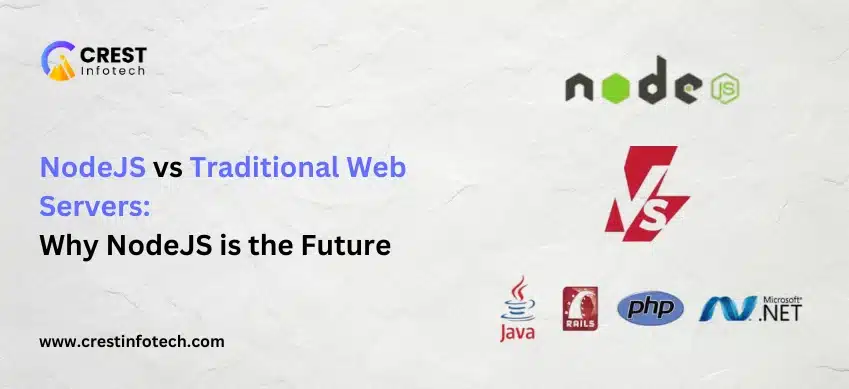Introduction
In the fast-evolving landscape of web development, choosing the right server technology can significantly impact the scalability, performance, and user experience of your application. Traditional web servers like Apache and Nginx have powered the internet for decades—but with the rise of real-time applications and JavaScript’s popularity, Node.js has emerged as a modern alternative that’s reshaping the server-side ecosystem.
In this article, we’ll compare Node.js with traditional web servers and explore why Node.js is considered the future of backend development.
What is Node.js?
Node.js is a runtime environment that allows developers to execute JavaScript on the server side. Built on Google Chrome’s V8 engine, Node.js uses an event-driven, non-blocking I/O model, making it lightweight, efficient, and perfect for data-intensive real-time applications.
Traditional Web Servers: Overview
Traditional web servers like Apache, Nginx, and IIS operate on a multi-threaded, synchronous model. Each incoming request is handled by spawning or managing separate threads or processes.
🔁 Key Characteristics:
- Synchronous (blocking) operations
- Heavy use of server resources for each connection
- Mature and stable with large community support
- Great for static content and PHP-based applications
Key Differences: Node.js vs. Traditional Web Servers
| Feature | Node.js | Traditional Web Servers |
|---|---|---|
| Architecture | Single-threaded, non-blocking | Multi-threaded, blocking |
| Language | JavaScript | Varies (PHP, Python, Ruby, etc.) |
| Performance | High for I/O-heavy apps | High for CPU-bound apps |
| Scalability | Excellent with event-driven model | Requires load balancers |
| Real-time Capabilities | Built-in with WebSockets support | Requires additional setup |
| Community & Ecosystem | Rapidly growing, npm packages | Mature, but language-dependent |
Why Node.js is the Future
1. 🚀 Non-Blocking I/O for High Performance
Node.js handles multiple requests asynchronously without blocking the main thread. This means it can serve thousands of concurrent users with minimal memory usage—perfect for modern applications that demand speed and responsiveness.
2. 🌐 JavaScript Everywhere
With Node.js, developers can use JavaScript on both the client and the server, enabling full-stack development with one language. This unification reduces complexity and enhances productivity.
3. 💬 Real-Time Applications Made Easy
Apps like chat systems, gaming platforms, and live updates thrive with Node.js. Thanks to libraries like Socket.io, building real-time, bidirectional communication systems is simple and efficient.
4. 📦 Massive npm Ecosystem
Node.js has access to npm, the world’s largest ecosystem of open-source libraries. This means faster development, better tooling, and community-driven innovation.
5. ⚙️ Microservices and API-Driven Architecture
Node.js is lightweight and perfect for building microservices and RESTful APIs. It encourages modular development, helping teams build, test, and scale applications more efficiently.
6. 🌍 Cloud-Native and Serverless Ready
Modern deployment platforms like AWS Lambda, Vercel, and Netlify provide seamless support for Node.js functions. Node is an ideal choice for serverless architectures, which prioritize performance and cost-efficiency.
Use Cases Where Node.js Excels
- Real-time chat apps
- Live streaming services
- RESTful APIs and GraphQL backends
- IoT applications
- Collaborative tools (like Google Docs-style apps)
- SPAs (Single Page Applications) with React, Angular, or Vue
Limitations to Consider
While Node.js is powerful, it may not be ideal for:
- CPU-intensive tasks (e.g., image/video processing)
- Traditional monolithic applications that don’t require real-time or high concurrency
However, these can be managed by offloading heavy tasks to worker threads or using microservices for separation of concerns.
Conclusion
Traditional web servers have had their time and continue to serve legacy systems and simpler web needs well. But as the web evolves, applications demand speed, scalability, and real-time functionality—and that’s exactly where Node.js shines.
With its asynchronous architecture, JavaScript unification, rich ecosystem, and future-proof capabilities, Node.js isn’t just a trend—it’s a strategic choice for modern web development.
🔮 The future is fast, event-driven, and JavaScript-powered. The future is Node.js.
Ready to modernize your backend? Start exploring Node.js today and experience the difference it brings to building high-performance, scalable applications.



